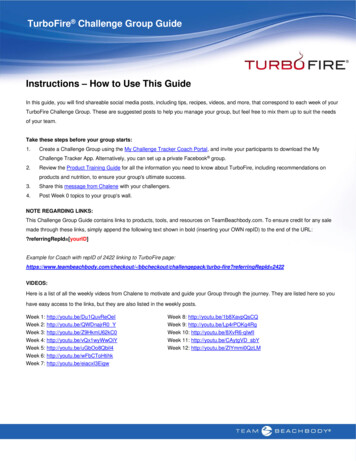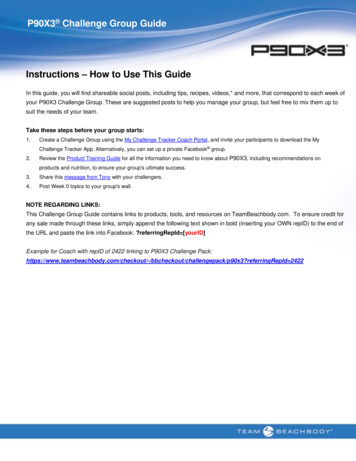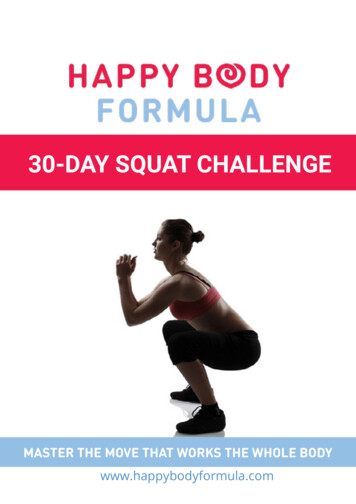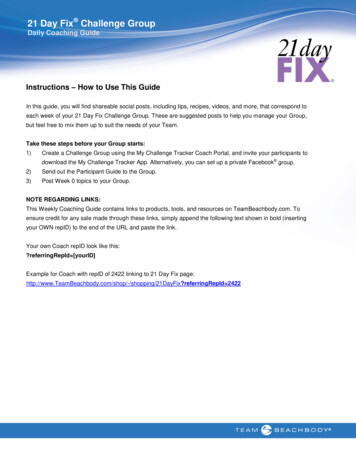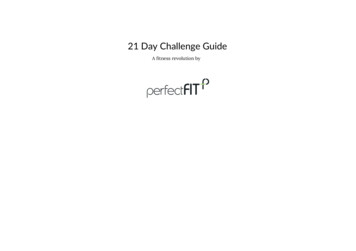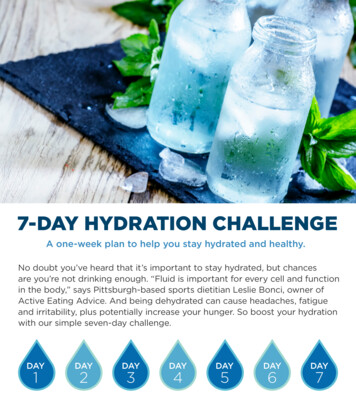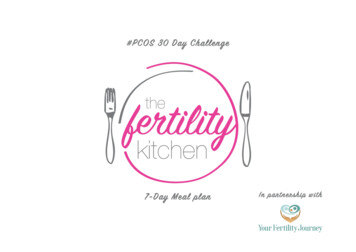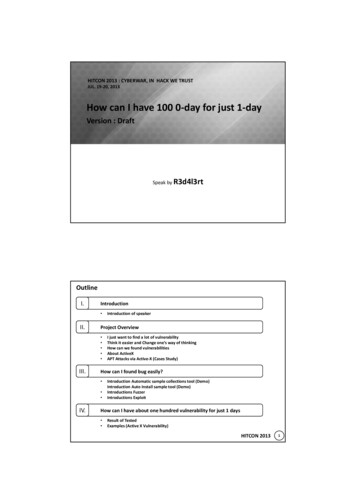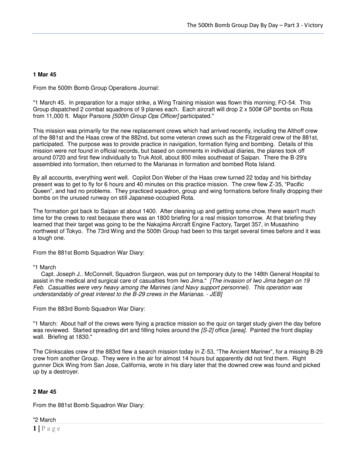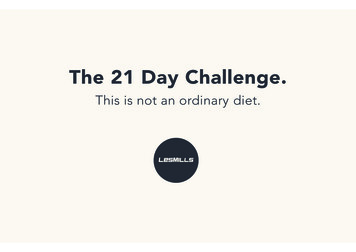
Transcription
The 21 Day Challenge.This is not an ordinary diet.
Welcome.THIS IS NOT AN ORDINARY DIET.THIS WILL CHANGE YOUR LIFE.Think of the 21 Day Challenge as a quick way to reset yourbody to healthier eating patterns, without forcing you tobecome “the one who’s on a diet”.So many diets promise to be easy, you’re assured that“you won’t even notice you’re dieting”. With the 21 DayChallenge that’s not the case. It will take some work, andthere will be times you wish you hadn’t signed up for it but you’re worth the effort!We promise that if you choose to put your body throughthis program, you are going to lose weight and fat, becomehealthier and you are going to teach your body to desirewhat it needs; you’ll create long-lasting, easy to maintainlifestyle habits that will not interfere with your family orsocial life.The best thing is, it only takes three weeks. That’s less timethan it took for THAT at-home fringe trim to grow out. Butunlike the fringe, we promise you will not regret doing this.You’ll only regret not trying it sooner.So, whywouldn’t youcommit?
Before you begin.Prior to commencing a purposeful change to your diet,you should first understand your regular eating routine bytracking everything you eat and drink for a week.Once you’ve determined your daily percentage ofcarbohydrates, you’ll need to make some changes to yourdiet, as outlined below:You can track your usual percentages of carbohydrates,proteins and fats with an online food diary – we suggestone of the following: Myfitnesspal.com Fitday.com My-calorie-counter.com Choosemyplate.org Livestrong.com/thedailyplate/ Myfooddiary.com If your regular carbohydrate intake is equal to orgreater than 55% of your total calories, reduce your %carbohydrates to 35% for one week and to 20% for asecond week. Then begin the 21 day challenge in thethird week.If your regular carbohydrate intake is less than 55% ofyour total calories, reduce your carbohydrates to 20%for one week and then begin the 21 day challenge thefollowing week.Sugar is a major contributor to carbohydrate intake aswell. Ensure that you are cutting out sugary foods anddrinks during this time also, as they’ll be completely cutout during the 21 days.In addition to providing you with an honest assessmentof your daily caloric intake (and where these calories arecoming from), keeping a food diary can also help preventmindless eating. If you record when you eat and how you’refeeling at the time, the diary will help you to recognize andcorrect negative eating patterns, such as a tendency to eatfor emotional reasons rather than hunger. If you see apattern of late night snacks, eating out of boredom orsadness, or recognize that celebratory meals are a bit outof hand, you can correct these behaviors and keep yournew healthy eating plan on track.If any of the following conditions apply to you, please seekmedical clearance before taking part in this challenge: Pregnancy Heart disease Diabetes Hypertension Obesity Musculo skeletal disorders that reduce your abilityto perform exerciseLike with any new diet or exercise routine, you should becleared by a medical professional before taking part.The 21 Day Challenge is not recommended for anyoneunder the age of 18 years.
What you’ll eat.Four meals a day that need to include:Protein1 palm full (size and thickness of the palm of your hand)of lean beef, lamb, chicken, duck, turkey, fish, shellfish,pork or eggsFatFoods to avoid:Shake Dairy products (except for 100% whey protein for yourdaily shake). Roasted or salted nuts – eat unsalted raw nuts as thefats in roasted nuts are really bad for you. Grains – wheat, cereals, oats, rice etc. Basically anythingthat comes in a cardboard box. A good idea is togo through your pantry and get rid of everything!Otherwise, store it where your family or flatmates caneasily access it, but it’s out of sight for you. Fruit. It’s only three weeks, you can live without applesfor three weeks, right? Legumes. Starchy vegetables – such as potato, kumara, parsnip,yams and pumpkin – you’re replacing these carbs withother vegetables. Soy products. Did you know they are actually carbs,not protein? Don’t be fooled by marketing. The onlyacceptable soy product is tamari soy sauce, as it doesn’tcontain wheat. Salt, dressings and fats in excess. You’ll see that someof the delicious recipes in your recipe booklet suggestsmall amounts of ingredients such as salt and mayonnaise.Don’t go overboard, these condiments and flavorsshould be enjoyed in small amounts only. Don’t forgetthat natural herbs and spices are a great way to addflavor and variety to your food.You’ll need to have it within 10 minutes of working out(you need 0.3 grams of protein per kg of body weight).You’ll need to source a 100% whey protein, or if you havea sensitivity to whey protein try rice or pea protein.Drinking shakes is a must! They will help you recover faster,keep your energy levels up and help you feel ready to workout again the next day. Even if you don’t do a workout ona particular day, you’ll still need to fit in a shake.A thumb size of nuts and seeds, avocado, olive oil,fish oil or flaxseed oil.Vegetables1-2 handfuls of broccoli, lettuce, cabbage, cauliflower,green beans, asparagus, mushrooms, brussels sprouts,cucumber, spinach, watercress, onions, all forms ofcapsicums, raw carrots, tomatoes, zucchini, eggplant.
What to drink?HydrationWater, herbal tea, black coffee, black tea. Sweeteners(including artificial ones) are a big no, no!That’s right, there’s no alcohol on this list. Think of it as21 days of bliss for your liver.Take your body weight in kilograms and multiply by 0.033;this is how many liters of water you’ll need to consumeeach day, plus one extra glass of water for every hour ofexercise. For example, if you’re 61kg and did 90 minutesof exercise in a day you would need 2 liters 1½ glassesof water.To get some extra trace minerals, add a small pinch ofunrefined sea salt to every liter of water – this will helpmaintain your hydration levels.Extra tips Never skip a meal. The planning will probably be thetoughest part of this three weeks, but it’s worth it. Whenyou skip a meal, you will be way more likely to over-eatlater on. If you are famished, have some nuts (6-8 nuts 1 serve). Always eat breakfast. Aim to eat your last meal at least two hours beforebed, so that your digestion process does not affectyour sleep and recovery (another common reason forovereating is tiredness). Eat different types of protein to get all the amino acidsand avoid food sensitivities.Water will not only hydrate you but also make you feelfuller and detox your body, flushing away any nasty toxinsand leaving you with that gorgeous glow.It won’t work if you cheat. It is tough. You’ll have momentswhere you want to scream at your children for asking for icecream, times where you want to knock your boyfriend outand steal his toast or ruin a 20-year friendship over whetheror not your friend orders a soy mocha latte.Hang in there! Take a deep breath and imagine themoment when you slide gracefully into those skinny jeansin three weeks’ time. All the pain forgotten.When you are in control of your mind, you’re in control ofyour life.
Measure your success.Aside from looking and feeling great, waist measurement isa great indicator of how you’re getting on.Why measure waist circumference?It’s a simple check to tell how much body fat you have andwhere it is placed around your body. Where fat is located isan important indication of your risk of developing ongoinghealth problems.No matter what your height or build, an increased waistlineis a sign that you could be at greater risk of developingserious health problems including type 2 diabetes, heartdisease, stroke, high blood pressure and some cancers.Measuring your waistline is a simple check. For an accuratemeasurement: Measure directly against your skin Breathe out normally Make sure the tape is snug, without compressingthe skin The correct place to measure your waist is horizontallyhalfway between your lowest rib and the top of yourhipbone. This is roughly in line with your belly button.What does your waist measurement mean?The waist measurements below (no matter what yourheight is) suggests you have an increased risk ofdeveloping a chronic disease:Increased risk: Men: more than 94 centimetres Women: more than 80 centimetresGreatly increased risk: Men: more than 102 centimetres Women: more than 88 centimetresCheck out more info at: nsf/Content/factsheet-waist-measurementTrust us, thisplan reallydoes work!
So now what?You’ve completed the challenge and you’re looking andfeeling incredible! Keep refined carbs and starchy vegetables low – as thisis where the main physical changes are made.Welcome back to the real world of food choices. Thatcroissant is no longer off-limits, you can finally curb yoursushi craving, the milk can go back in your coffee so howdo we live with the food we love, while maintaining thegreat results? Here are some suggestions: If you’re wanting carbs, stick with the low G.I. kind asthey enter the blood slowly giving you a much moresustained energy response and mean you’ll take in lesscarbohydrates in total. Use the hand eyeball method (that is 1 palm full ofprotein, 1-2 handfuls vegetables and a thumb size offat) to monitor your portion sizes so that you can eatsome of the foods you love and have missed. Still stay away from processed foods as much aspossible, as this is better for long-term health. By doingthis, you’re eliminating food colorings, preservativesand sweeteners which are all harmful to your health. Eat like you’re still on the challenge 80% of the time,and then eat what you want for the other 20%. Stay with a palm of protein each time you sit down toeat a meal, as well as the thumb of good fats. When adding fruits back in, choose those with darkskins as they have higher antioxidant levels and lowerGlycemic load. Berries and grapes are better choicesthan bananas and pineapple. When fruits are dried, theGlycemic index goes up because of the dehydration ofthe fruit so easy on these!Check out the website www.glycemicindex.com formore information on the G.I. of foods. Unsweetened yoghurt, nuts and seeds are great fora snack.The LES MILLS Food Pyramid is made up of healthy,whole, clean, nutrient-rich foods. This includes:FatsEssential fatty acids that support thecardiovascular, reproductive, immuneand central nervous systems.ProteinsProteins, which are the building blocksfor our bodies. These are essential forthe growth and the formationof hormones.CarbsCarbohydrates, which are broken downin the body to give us energy.Use the 21 Day Challenge Recipe Booklet to help keepmeals interesting and varied.Good luck and remember who’s now in charge!
The Les Mills Food Pyramid.Oils/Nuts/SeedsLean Animal ProteinLow Starch (Low GI)High Starch (High GI)
7 Day Eating Plan.Here is a week of 21 Day Challenge meal ideas to getyou started!All the recipes with an * are available in your recipe book.Day 1Meal 1 – Vegetable Frittata*Meal 2 – Steak and stir fried vegesMeal 3 – Prawn KebabsMeal 4 – Mediterranean Chicken Stack*Day 2Meal 1 – Omelette with tomato, spinach,onion, garlic and capsicumMeal 2 – Steak and saladMeal 3 – Chicken patties with guacamoleand salsa*Day 3Meal 1 – Naked Huevos Rancheros with salsa,avocado and capsicum*Meal 2 – Spiced Mince*Meal 3 – Chicken patties with kale salad*Meal 4 – Steak fajitas with lettuce tortillasMeal 4 – Prawns and cabbage*Day 5Meal 1 – Silverbeet fritters with mayonnaise*Meal 2 – Sashimi and saladMeal 3 – Salmon with broccoli saladMeal 4 – Lamb rack with cauliflower mash*Day 6Meal 1 – Poached eggs on grilled eggplantand mushroomsMeal 2 – Fish hash with carrot salad andred onionMeal 3 – Chicken sausages with cruditésMeal 4 – Silverbeet mince wrapsDay 7Meal 1 – Minced beef with onions, zucchiniand mushroomsMeal 2 – Pork lettuce cupsMeal 3 – Chicken saladMeal 4 – Fish and cucumber saladDay 4Meal 1 – Chilli Scrambled Eggs on roasttomatoes and baby spinachMeal 2 – Lamb and egg stack with tomatoesand avocado*Meal 3 – Chicken lettuce cupsMeal 4 – Meatballs on grated carrot and celery
FAQS.I train early in the mornings. Do I eat breakfast beforethe workout or after?I normally eat cereal or toast for breakfast. What canI eat for breakfast on this plan?Eat breakfast 1½ to 2 hours before the class as long as itdoes not disrupt your sleep. For example, if the class is at6 a.m. and you have to get up at 4 a.m. to eat breakfast,then you are disrupting your sleep.Try an omelet filled with vegetables or grilled chickenwith salad.If that is the case, it is probably best to skip breakfast andhave your post-workout shake immediately after finishingthe class, then eat breakfast within an hour of finishingthe workout.This may not seem ideal or what you are used to but thistype of breakfast will set you up for better energy levelsthrough the day.What if I can’t live without yoghurt/chocolate, orcoffee with milk?As your body begins to hydrate itself, you may indeedexperience frequent trips to the toilet.If you have a ‘non-negotiable’ that you cannot live withoutthen you are welcome to keep it in your diet, but it willslow down your progress and in some cases, dependingon how much of the ‘non- negotiable’ you have, it willstop your progress altogether.To help with this you can add a pinch of unrefined seasalt to each liter of water. This also increases the mineralcontent of the water to help you stay hydrated.What exactly can I have in terms of condiments,sauces etc?I’ve started drinking the suggested amount of water andI have to go to the toilet a lot. How can I prevent this?It is best to sip water throughout the day rather thandrinking a whole glass at a time. This helps to keep youconstantly hydrated.All herbs and spices are allowed.Tomato-based sauces arebest but look for ones without sugar.You can also have mustards and balsamic vinegar. So, lookfor condiments and sauces that have no sugar or grainbased products in them. And look for gluten free on thelabel. Tamari soy sauce is OK in small amounts - but usejust enough to lightly flavour the food. Use salt and naturalmayonnaise in small amounts.What is a grain?Grains are a carbohydrate. They include: Wheat – all types including spelt and bulgur Rice – wild, brown, white and coloured Oats including oatmeal Corn including popcorn and cornmeal Millet Quinoa Rye Teff Sorghum (also called Milo) Triticale All cerealsWhat if I fall off the plan?Simply get back on it as quickly as you can. Progress andoverall results will be limited if you don’t stick with the planfor the full 21 days.If I’m not eating grains, where do I get my fiber from?There is eight times more fiber in non-starchy vegetables,such as leafy greens, than in grains.This means that by eating 1 to 2 handfuls of vegetables ateach meal you’ll be getting plenty of fiber.This also means that eating these vegetables at eachmeal is extremely important to keep your digestive systemmoving.
What do I do when I feel tired?When should I have my last meal for the day?In the first 7 to 14 days you may feel tired as your bodyadjusts to the change in macronutrient composition.Try to stop eating 2 hours before bedtime so the digestionprocess does not affect your sleep and recovery.This is a good time to make sure you have your foodorganized, ready to eat in the correct portions of protein,carbohydrates and good fats.I’m a vegetarian and would like to do the 21 DayChallenge. Is this possible?Make sure you’re having all of your meals at regularintervals each day and before you know it, your energylevels will be better than ever!If I’m not eating milk products how will I get the rightamount calcium?All green vegetables contain calcium as well as most nutsand seeds, especially sesame seeds, almonds and brazilnuts.Good choices of green vegetables that are high in calciumare spinach, kelp, collard greens, kale, broccoli and celery.Many green vegetables have a better calcium-absorptionrate compared with milk products.Eating lots of vegetables in your diet will help preventbone deterioration.Unfortunately, if you eat a diet which does not includeanimal protein, we do not recommend you attempt the21 Day Challenge. Les Mills advocates eating a variety ofmeat, chicken and fish in your diet as a great source ofprotein.
greater than 55% of your total calories, reduce your % carbohydrates to 35% for one week and to 20% for a second week. Then begin the 21 day challenge in the third week. If your regular carbohydrate intake is less than 55% of your total calories, reduce your carbohydrates to 20% for one week
